Difference between revisions of "Sheep leather"
(Created page with "<p align=center> 300px </p> == Schafsleder == Auf der Welt gibt es ca. 1,2 Mrd. Schafe und Lämmer. Davon werden jährlich 15 bi...") |
|||
| (20 intermediate revisions by one user not shown) | |||
| Line 4: | Line 4: | ||
| − | == | + | == Sheep leather facts== |
| − | + | There are about 1 billion sheep and lambs in the world of which 15 to 25% are slaughtered annually. Sheep leather, [[lamb leather]] and [[Sheepskin - Lambskin|lambskin]] are second behind [[cow leather]] with about 10% of world production. 90% of the sheep are woolly sheep. The finer and denser the wool, the thinner and worse the [[leather quality]]. Sheep leather is used for [[Leather book cover|book covers]], [[leather clothing|clothing]], [[leather gloves|gloves]], [[leather accessories]] and occasionally for [[leather furniture|furniture]]. Sheepskin is also called "mouton leather." | |
| − | + | ||
| + | <p align=center> | ||
| + | [[bild:Sheepskin Jacket.jpg|500px]] | ||
| + | </p> | ||
| + | <p align=center> | ||
| + | ''Typical sheep [[Leather clothing|leather jacket]].''<br></p> | ||
| + | <p> </p> | ||
| + | |||
| + | Italy is by far the largest [[leather production|producer]] of sheep and [[Goatskin|goat]] leather in Europe. Almost 34 million square metres of sheep and goat leather were produced in Italy in 2011. In the same period, almost 100 million square metres of [[cow leather|bovine leather]] were produced in Italy. Germany, the [[leather industry|third largest leather producer]] in Europe, after Spain, produces approximately 500,000 square metres of sheep and goat leather in the same year and approximately 8.5 million square metres of [[cow leather]]. | ||
| Line 14: | Line 22: | ||
</p> | </p> | ||
<p align=center> | <p align=center> | ||
| − | '' | + | ''The [[Leather hair pores - Hair follicles|hair pores]] in sheep leather.''<br></p> |
<p> </p> | <p> </p> | ||
| Line 21: | Line 29: | ||
</p> | </p> | ||
<p align=center> | <p align=center> | ||
| − | '' | + | ''For [[leather furniture|furniture]], solid sheep leather with [[Natural leather grain|smooth surfaces]] are processed.''<br></p> |
<p> </p> | <p> </p> | ||
| − | + | Sheepskin is structurally related to [[goatskin]], but as hairless leather, it is less valuable because sheep breeds are bred for wool production. There are countless sheep breeds with significant differences in the quality of their hides. Even within the same breed, significant differences can occur due to environmental conditions (climate, surroundings, diet). The main difference from goatskin is the high content of natural fats in sheepskin (fat content approx. 20%), which makes the leather slightly less [[leather quality|tear-resistant]] compared to goatskin(fat content approx. 2-4%). The fat in the leather is removed during [[leather production]] and the [[leather#What does leather consist of?|fiber structure]] of the leather is less dense in these areas than in goatskin, which makes the leather [[Thickness of leather|thicker]] and [[Haptic evaluation of leather surfaces|softer]], at least in comparison. | |
| − | + | ||
| + | == Sheep leather furniture== | ||
| + | [[leather furniture|Furniture]] made of sheep leather is rare. Sheep leather furniture is then processed as patinated, [[Porous leather|porous]] [[aniline leather]]. | ||
| Line 33: | Line 43: | ||
[[bild:Schafsleder-Sessel-03-2011-.jpg|250px]] | [[bild:Schafsleder-Sessel-03-2011-.jpg|250px]] | ||
</p> | </p> | ||
| − | |||
| − | |||
| − | |||
| − | |||
<p align=center> | <p align=center> | ||
| Line 49: | Line 55: | ||
<p align=center> | <p align=center> | ||
| − | [[bild:Sessel-Schafsleder-02.jpg| | + | [[bild:Sessel-Schafsleder-02.jpg|500px]] |
| − | + | ||
</p> | </p> | ||
| − | |||
| − | |||
<p align=center> | <p align=center> | ||
| − | |||
[[bild:Schafsleder-Hocker-01.jpg|250px]] | [[bild:Schafsleder-Hocker-01.jpg|250px]] | ||
| + | [[bild:schafsofa0509.jpg|250px]] | ||
| + | </p> | ||
| + | <p align=center> | ||
| + | [[bild:schafsessel0509.jpg|500px]] | ||
</p> | </p> | ||
<p align=center> | <p align=center> | ||
| − | '' | + | ''Typical sheep leather furniture.'' |
</p> | </p> | ||
| − | + | A special method for increasing the [[Natural leather grain|grain structure]] of sheep leather is [[Shrunken leather - leather shrinkage|shrinkage]]. This is used in France, where the leather is called "Basane de Mouton". It is a [[vegetable-tanned leather]]. Sheepskins are selected with a [[Natural leather grain|strong grain]] at the neck, which is called "moutonage". It is similar to the neck leather from [[cow leather|cattle]]. | |
<p align=center> | <p align=center> | ||
| − | [[bild: | + | [[bild:Sheep leather-01.jpg|500px]] |
</p> | </p> | ||
<p align=center> | <p align=center> | ||
| − | ''[[ | + | ''[[Shrunken leather - leather shrinkage|Shrunken]] sheep leather ([http://brocantique.de www.brocantique.de]).''<br></p> |
<p> </p> | <p> </p> | ||
| − | |||
| − | |||
| − | |||
== Additional information == | == Additional information == | ||
| − | * [[ | + | * [[Lamb leather]] |
| − | * [[ | + | * [[Sheepskin - Lambskin]] |
| − | * [[ | + | * [[Goatskin]] |
| − | + | ||
* [[Skiver]] | * [[Skiver]] | ||
Latest revision as of 07:30, 25 July 2023
Sheep leather facts
There are about 1 billion sheep and lambs in the world of which 15 to 25% are slaughtered annually. Sheep leather, lamb leather and lambskin are second behind cow leather with about 10% of world production. 90% of the sheep are woolly sheep. The finer and denser the wool, the thinner and worse the leather quality. Sheep leather is used for book covers, clothing, gloves, leather accessories and occasionally for furniture. Sheepskin is also called "mouton leather."
Typical sheep leather jacket.
Italy is by far the largest producer of sheep and goat leather in Europe. Almost 34 million square metres of sheep and goat leather were produced in Italy in 2011. In the same period, almost 100 million square metres of bovine leather were produced in Italy. Germany, the third largest leather producer in Europe, after Spain, produces approximately 500,000 square metres of sheep and goat leather in the same year and approximately 8.5 million square metres of cow leather.
The hair pores in sheep leather.
For furniture, solid sheep leather with smooth surfaces are processed.
Sheepskin is structurally related to goatskin, but as hairless leather, it is less valuable because sheep breeds are bred for wool production. There are countless sheep breeds with significant differences in the quality of their hides. Even within the same breed, significant differences can occur due to environmental conditions (climate, surroundings, diet). The main difference from goatskin is the high content of natural fats in sheepskin (fat content approx. 20%), which makes the leather slightly less tear-resistant compared to goatskin(fat content approx. 2-4%). The fat in the leather is removed during leather production and the fiber structure of the leather is less dense in these areas than in goatskin, which makes the leather thicker and softer, at least in comparison.
Sheep leather furniture
Furniture made of sheep leather is rare. Sheep leather furniture is then processed as patinated, porous aniline leather.
Typical sheep leather furniture.
A special method for increasing the grain structure of sheep leather is shrinkage. This is used in France, where the leather is called "Basane de Mouton". It is a vegetable-tanned leather. Sheepskins are selected with a strong grain at the neck, which is called "moutonage". It is similar to the neck leather from cattle.
Shrunken sheep leather (www.brocantique.de).
Additional information







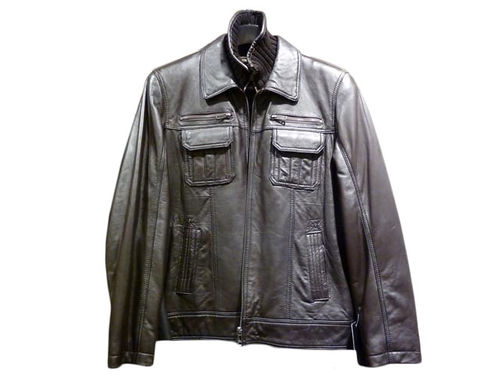


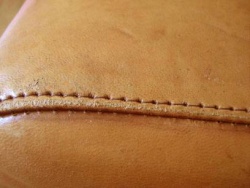
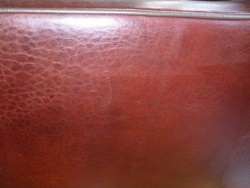
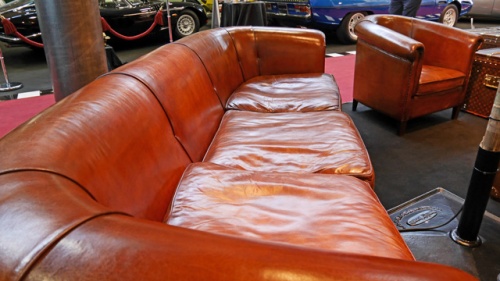
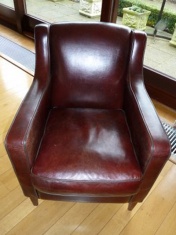
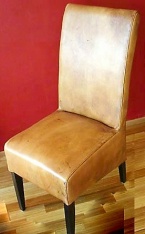
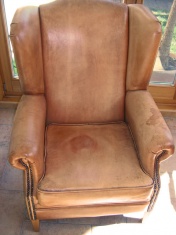
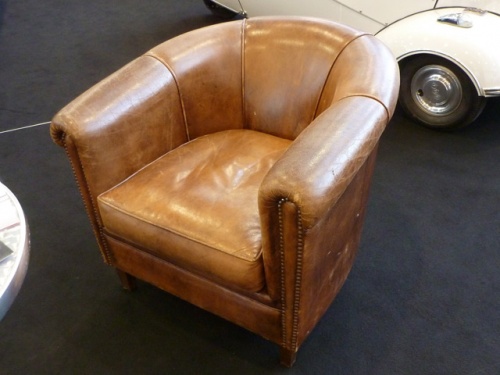
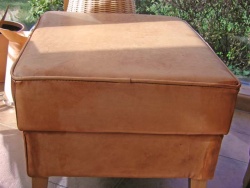
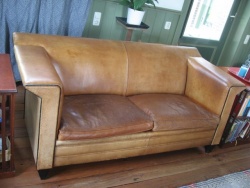
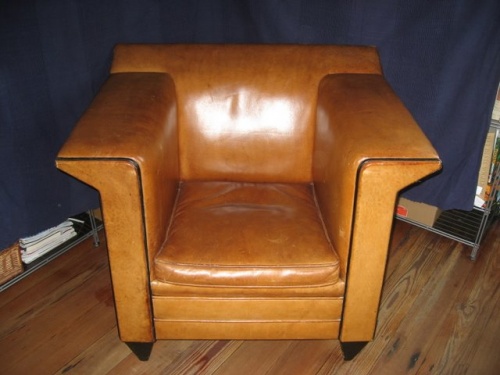
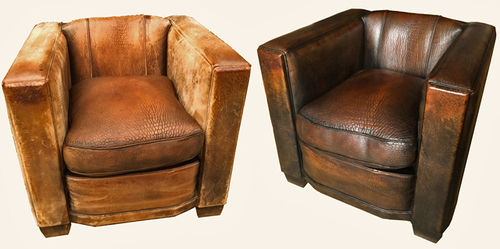

 a kotori web solution
a kotori web solution